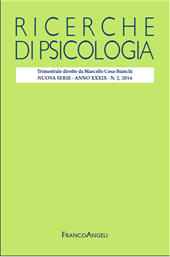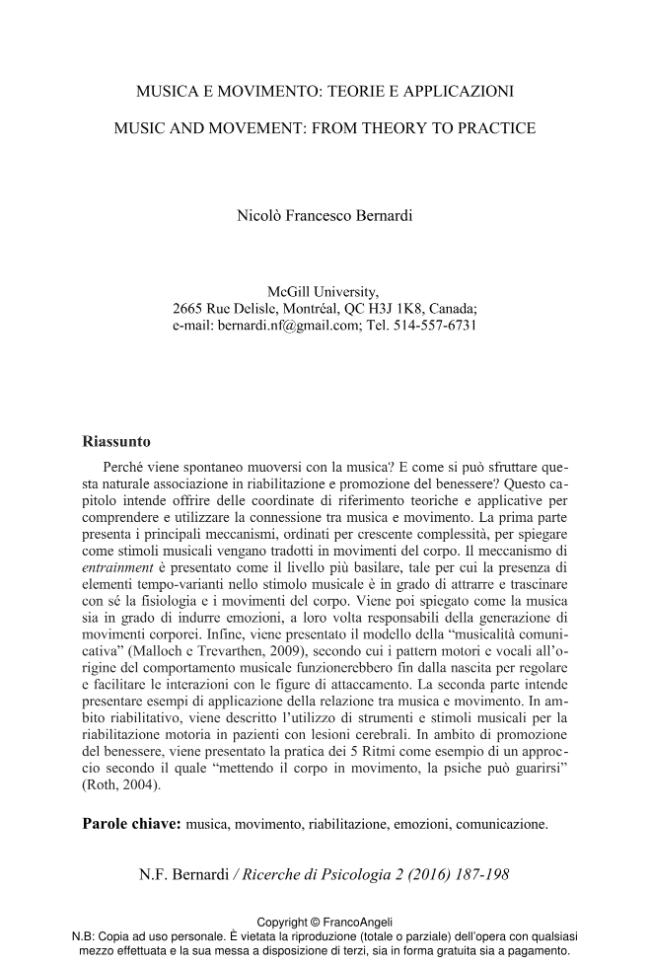Musica e movimento : teorie e applicazioni
187-198 p.
Perché viene spontaneo muoversi con la musica? E come si può sfruttare questa naturale associazione in riabilitazione e promozione del benessere? Questo capitolo intende offrire delle coordinate di riferimento teoriche e applicative per comprendere e utilizzare la connessione tra musica e movimento. La prima parte presenta i principali meccanismi, ordinati per crescente complessità, per spiegare come stimoli musicali vengano tradotti in movimenti del corpo. Il meccanismo di entrainment è presentato come il livello più basilare, tale per cui la presenza di elementi tempo-varianti nello stimolo musicale è in grado di attrarre e trascinare con sé la fisiologia e i movimenti del corpo. Viene poi spiegato come la musica sia in grado di indurre emozioni, a loro volta responsabili della generazione di movimenti corporei. Infine, viene presentato il modello della "musicalità comunicativa" (Malloch e Trevarthen, 2009), secondo cui i pattern motori e vocali all'origine del comportamento musicale funzionerebbero fin dal
la nascita per regolare e facilitare le interazioni con le figure di attaccamento. La seconda parte intende presentare esempi di applicazione della relazione tra musica e movimento. In ambito riabilitativo, viene descritto l'utilizzo di strumenti e stimoli musicali per la riabilitazione motoria in pazienti con lesioni cerebrali. In ambito di promozione del benessere, viene presentato la pratica dei 5 Ritmi come esempio di un approccio secondo il quale "mettendo il corpo in movimento, la psiche può guarirsi" (Roth, 2004).
Music and movement. From theory to application. Why do we move our body with the music? And how can we use this natural connection for rehabilitation and for promoting well-being? This essay aims to offer theoretical and practical coordinates to understand and make use of the association between music and movement. The first part describes the main mechanisms responsible for the translation of music stimuli into body movements, ordered by increasing complexity. Entrainment is presented as the most basic phenomenon, by virtue of which the presence of time-varying elements in the music stimuli can attract body movements and physiology. The way in which music evokes emotions is then described, as emotions are themselves involved in the generation of motor patterns. Finally, the "model of communicative musicality" (Malloch & Trevarthen, 2009) is presented. According to this view, the vocal and motor patterns utilized in the early exchanges between newborns and their caregivers would be at the root of adult music.
behaviors, hence the association between music and movements would be fundamentally interactive in nature. The second part aims to present examples of how the relationship between music and movement can be applied. In rehabilitation, the use of music stimuli and musical instruments is described as a strategy to facilitate motor recovery in patients suffering from acquired brain injuries. In the context of well-being promotion, the 5 Rhythms approach is described as an example of a practice based on the idea that "Put your body in motion and your psyche will heal itself" (Roth, 2004).
Ist Teil von
Ricerche di psicologia : 2, 2016-
Artikel aus derselben Ausgabe (einzeln erhältlich)
-
Informationen
ISSN: 1972-5620
THEMENBEREICHE
KEYWORDS
- Musica, movimento, riabilitazione, emozioni, comunicazione
- Music, movement, rehabilitation, emotions, communication



